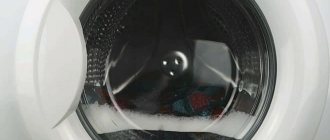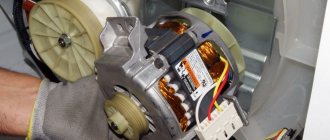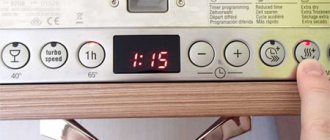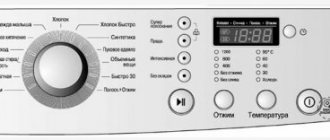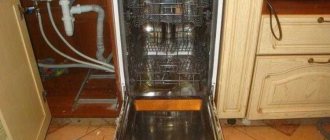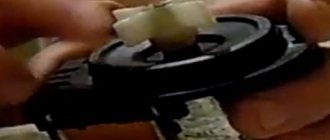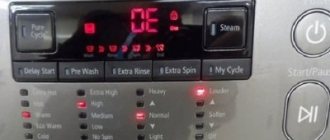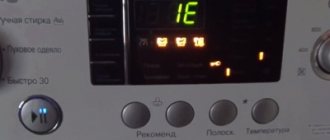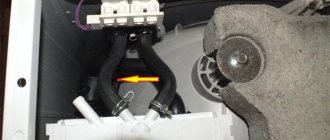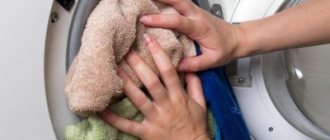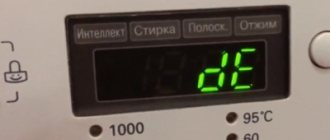If during washing the washing machine takes in water and then immediately drains it, it is impossible not to notice it. The cycle lengthens noticeably, the noise of liquid being flushed down the drain is constantly heard, and things remain dirty.
This can be caused by a variety of reasons, but the most common are:
- when connecting the device to the sewer, the water drain hose was installed incorrectly;
- blockage in the sewer system;
- malfunction of the dirty fluid drain valve;
- damage to the pressure switch;
- The electronic module has failed.
It is recommended to start fixing the problem immediately - a breakdown of this kind can lead to severe wear and tear on the internal elements of the machine or flooding of the apartment.
Incorrect sewer connection
The most common problem that arises after installing new equipment or when moving old equipment to another location.
To check if the hose position is incorrect, you can use two methods:
- Visual inspection. The hose must be fixed above the level at which the washing machine tank is located (approximately half a meter from the floor level or slightly higher). This position eliminates the situation of spontaneous leakage of liquid from the tank. Otherwise, the collected water will be drained, the level sensor will react to a decrease in the water level and send a signal to add new water. The cycle will repeat.
- If you cannot get to the hose, then use the second method to check its correct position. Start the wash cycle and wait to see if the machine starts draining water. If the answer is yes, then the cause of the failure has been identified. Dealing with it on your own is quite simple - you should change the position of the hose in accordance with the standards.
Usually, the machine comes with a special plastic loop that needs to be attached to the back wall of the device and the hose passed through it.
Broken water level sensor
One of the reasons why the washing machine constantly drains water is a broken water level sensor. The water only reaches a certain level. This is monitored by a water level sensor. And if this sensor fails, then upon reaching a certain threshold, excess water will automatically be discharged outside. Unfortunately, such sensors cannot be repaired. It needs to be replaced with a native one or a similar one. You can also find and purchase a water level control sensor in a store, or you can replace it yourself.
Breakdown of the pressure switch
If the device previously worked properly, but now it collects and immediately drains water, then the breakdown may be caused by a failed part.
The pressure switch is responsible for controlling the water level in the tank. When the container is filled to the required level, the sensor gives a signal and the collection of water into the unit is completed.
The pressure switch fails if:
- contacts have oxidized;
- contacts close;
- the membrane is depressurized;
- the pressure pipe is clogged or damaged.
Incorrect operation of the pressure switch can lead to the tank overflowing and water from the machine to leak into the apartment and onto the lower floors.
Solution
Before carrying out any repair work, be sure to disconnect the device from the network.
The water level sensor is located on the rear of the machine. To get it yourself, remove the cover of the device and find the pressure switch. Remove the fasteners, inspect the condition of the part to see if there are any traces of oxidation on the contacts. If they are oxidized, they need to be cleaned.
A sensor tube covered in cracks is a reason to completely replace the unit. Its cost is low, and the process itself is simple.
Procedure for replacing the sensor:
- Disconnect the thin hose going to the compression chamber from the sensor.
- Disconnect the terminals, unscrew the 2 screws securing the pressure switch, and remove it.
- Secure the new one in its place and screw in the screws.
- Connect the terminals.
- Reconnect the thin hose.
- Replace the washing machine cover.
Before assembling the lid, you can carefully, observing safety precautions, start the machine to work without laundry in the drum. If the washing goes well, then the problem is resolved and the case can be assembled. Remember to unplug the device again before starting work. But if the device is still faulty and immediately drains water as soon as it fills, then the reason is different.
Why does the washing machine constantly collect liquid and not wash?
Let's look at the most common causes of the problem in more detail:
- Incorrect connection. Installing new equipment or replacing old equipment requires professional connection of the machine. When connecting yourself, you may make a common mistake that leads to a problem: the location of the hose is lower than required by the instructions, which causes the liquid to drain.
- Valve fault. The liquid discharge valve is designed to ensure the tightness of the outlet. A breakdown of the element causes the pump to turn on, but water is not poured into the centrifuge, but is drained from it. The liquid level sensor (pressostat) receives information about an insufficient amount of liquid, the sensor is triggered, and the electronic control of the washing machine interrupts the washing program.
- Problems with pressure in pipes. If the pressure in the water supply pipes is low, the water filling the drum does not flow in the required volume, which leads to an emergency discharge of the liquid. Excessive pressure in the water supply does not allow the valve cover to completely shut off the flow of liquid; it may begin to fill the tank non-stop, which will trigger the pressure switch.
- Sewer blockage. A blockage in a narrow sewer pipe on the ground floor leads to a “vacuum” effect; liquid from household appliances is simply drawn into the sewer.
- Damage to the liquid level sensor. A broken element sends a false signal about the amount of water to the control module. The electronics react like this: liquid enters in a large volume, fills the drum, and drains through the hose. In some cases, incorrect operation of the sensor leads to the emergency drain mode being triggered and the pump starting to discharge water.
- External leaks. A leak in the washing machine drum, cracks in the hoses, damage in the pump body, and broken seals in the connections lead to the appearance of traces of liquid around household appliances.
- Electronics failure. Water is constantly drained if a broken control unit sends the wrong command to the dump valve. A software glitch causes the device to continuously pour and drain liquid. The contact may have come loose or the module needs to be rebooted. An electronic malfunction cannot be repaired without the help of a home appliance repairman.
Read more ► The washing machine does not spin: causes and troubleshooting, how to fix it without repair
Drain valve failure
If the drain valve is not working, the washing machine constantly draws water into the tank. This problem can be resolved by completely replacing the component.
Before starting work, the machine is disconnected from the network. For a device with vertical loading, remove the side panel (the valve is located at the bottom); for a horizontal device, remove the top cover; the required element is located immediately below it. It is necessary to select a valve that is completely identical to the one removed. When purchasing it, also purchase the clamps that will be needed to secure the wires and hoses.
Replacement procedure:
- Find the valve and carefully disconnect the hoses and wires from it.
- Unscrew the screws or bend the latches, depending on the type of valve fixation.
- Turn the part and remove it.
- Install the new valve, secure it, attach hoses and wires, secure them with clamps.
- Replace the panel.
How to properly connect to the sewer
For the washing machine to work correctly, it is important to connect it to the sewer correctly. The connection method depends on the type of equipment, so the following points should be considered:
- If the machine is not equipped with a check valve that allows water to flow only in one direction, then the suitable height for the drain hose is 50 cm.
- To eliminate the possibility of leakage, you need to connect the drain hose to the sink above the knee. For this purpose, an additional sewer siphon will be required.
- By analogy with connecting through a siphon, you can connect a hose to the water drainage system from the bathtub. You should choose the appropriate option depending on the location of the machine and the location of communications.
- Regardless of how the drain is arranged, the hose is attached to the back wall of the washing machine, avoiding twisting and kinking, so that water can constantly flow into the sewer.
- The drain can be done directly into the sewer by installing a drain. For a reliable connection, it is recommended to use a rubber seal.
Electronic module failure
Problems with water intake and drainage may be caused by a malfunction of the electronic module. In this case, the display, if available, displays an error code to help you figure out what the reason is. Try rebooting the device completely and starting it again. If after this the washing machine again drains water immediately after filling, it is recommended to call a specialist. In this case, it will be quite difficult to independently identify and eliminate the problem.
Any breakdown requires prompt repair. If you continue to try to operate the washing machine when it is draining water, you can permanently damage the equipment.
What it is not recommended to do on your own
Let's consider situations where the reason is clear, but you cannot do without the help of a specialist. Fixing the problem yourself can lead to undesirable consequences.
Trying to fix a broken intake or exhaust valve
The inlet (inlet) valve is a device necessary for the dosed supply of water into the tank. When voltage is applied to the coil, an electromagnetic field is generated. It acts on the magnetic rod, drawing it into the coil. At the same time, the membrane opens and water flows into the outlet fitting of the valve. From there, the liquid medium penetrates into the washing machine tank. After it is filled, the power to the coil is turned off, and the membrane takes its original position, blocking the access of water.
You can determine that the problem is in this block in the following ways:
- Check the valve mesh. If necessary, it can be cleaned. If there is a blockage in this place, the washing machine will either not fill the water or the tank will fill slowly.
- If the valve does not open, you need to check the coil. There was probably a burnout. With this malfunction, water will not flow during one of the washing modes.
The pressed-in plastic inserts in the fittings are also subject to inspection. They are responsible for reducing the water supply. If the inserts fall out, the amount of water passing through increases. This valve needs to be replaced.
Replace the pressure switch - water level sensor
The part, which is a sensor for determining the water level in the drum, sends signals to the control module. A malfunction of the pressure switch is quite easy to notice. The machine starts the washing program without adding water. Another situation is that the drum picks up too much or too little liquid. The rinsing and spinning stages are disrupted. A broken sensor may also be indicated by a lack of drainage.
Troubleshoot a tank leak
If the tank is leaking, there may be 2 reasons:
- the tank body is cracked;
- damage to the joints of parts.
It is useless to try to fix cracks yourself with waterproof glue: the result will not last long. Therefore, the tank will have to be replaced or another gasket placed at the junction of the parts.
Replace the electronic control module
One of the most common malfunctions is related to the electronic unit. No well-known brand is immune to this problem. The electronic module is responsible for thermal indication, water level, displays information on the operation of the device on the display, and is responsible for the washing and rinsing speed. Such breakdowns require replacement of the element.
Replace belt
If the drum rotates very slowly during washing, with scraping sounds, or does not rotate at all, an error code appears on the display, most likely the drive element is damaged. If the belt breaks, it can break the wiring or damage the sensors. The causes of this problem can be either improper operation of the machine or wear and tear over its service life. Moreover, narrow washers, as a rule, wear out faster due to the close arrangement of parts.
Connection
If the automatic washing machine is incorrectly connected to the sewerage system, then a “siphon effect” or, in other words, “self-draining” occurs. That is, water flows out of the washing machine itself, without the help of a drain pump. Many people don't even understand this. Some SMAs stop and display an error code, which means there is not enough water in the tank. Others are constantly adding it. In principle, if an error does not occur, then you can operate the machine this way. But this leads to significant waste of water and electricity.
Based on this, it seems optimal to connect to a special outlet above the sink siphon, or attach it to the edge of the bathroom using a bend. But this option, for aesthetic reasons, not everyone likes.
